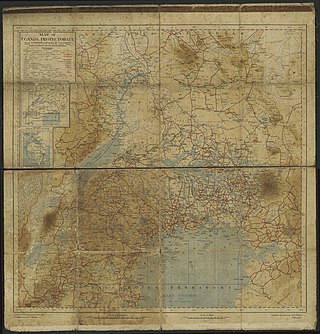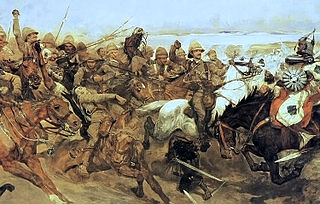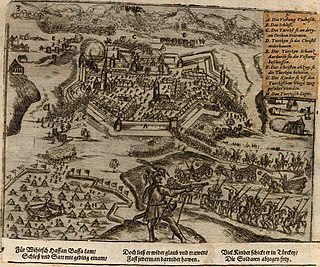
William Grant Stairs was a Canadian-British explorer, soldier, and adventurer who had a leading role in two of the most controversial expeditions in the Scramble for Africa.

Mehmed Emin Pasha was an Ottoman physician of German Jewish origin, naturalist, and governor of the Egyptian province of Equatoria on the upper Nile. The Ottoman Empire conferred the title "Pasha" on him in 1886, and thereafter he was referred to as "Emin Pasha".

The Emin Pasha Relief Expedition of 1887 to 1889 was one of the last major European expeditions into the interior of Africa in the nineteenth century. Led by Henry Morton Stanley, its goal was ostensibly the relief of Emin Pasha, the besieged Egyptian governor of Equatoria, who was threatened by Mahdist forces.

Dufile was originally a fort built by Emin Pasha, the Governor of Equatoria, in 1879; it is located on the Albert Nile just inside Uganda, close to a site chosen in 1874 by then-Colonel Charles George Gordon to assemble steamers that were carried there overland. Abandoned by Emin's people in January 1889, Dufile being within the Lado Enclave was reoccupied and reconstructed by Belgian forces from 1902 to 1907.

Al-Zubayr Rahma Mansur Pasha, also known as Sebehr Rahma or Rahama Zobeir, was a slave trader in the late 19th century. He later became a pasha and governor in Sudan.

The Mà'dí are a Central Sudanic speaking people that live in Magwi County in Eastern Equatoria, South Sudan and the districts of Adjumani and Moyo in Uganda. From south to north, the area runs from Nimule, at the South Sudan-Uganda border, to Nyolo River where the Ma’di mingle with the Acholi, the Bari, and the Lolubo. From the east to west, it runs from Parajok/Magwi to Uganda across the River Nile.

Wadelai was a boma at a narrow point on the Albert Nile in what is now northern Uganda. There were several shortlived colonial stations there, the first being the final chief station of Emin Pasha when Governor of Equatoria. Wadelai gives its name to a current Ugandan sub-county.

Turco-Egyptian Sudan, also known as Turkiyya or Turkish Sudan, describes the rule of the Eyalet and later Khedivate of Egypt over what is now Sudan and South Sudan. It lasted from 1820, when Muhammad Ali Pasha started his conquest of Sudan, to the fall of Khartoum in 1885 to Muhammad Ahmad, the self-proclaimed Mahdi.

The siege of Khartoum took place from 13 March 1884 to 26 January 1885. Sudanese Mahdist forces captured the city of Khartoum from its Egyptian garrison, thereby gaining control over the whole of Sudan.

The First and Second Battles of El Teb took place during the British Sudan Campaign where a force of Sudanese under Osman Digna won a victory over a 3,500 strong Egyptian force under the command of General Valentine Baker which was marching to relieve Tokar on the 4th. A second British force under Sir Gerald Graham arrived on the 29th, engaging and defeating Osman Digna with few casualties.

The Mahdist War was a war between the Mahdist Sudanese, led by Muhammad Ahmad bin Abdullah, who had proclaimed himself the "Mahdi" of Islam, and the forces of the Khedivate of Egypt, initially, and later the forces of Britain. Eighteen years of war resulted in the creation of Anglo-Egyptian Sudan (1899–1956), a de jure condominium of the British Empire and the Kingdom of Egypt in which Britain had de facto control over Sudan. The Sudanese launched several unsuccessful invasions of their neighbours, expanding the scale of the conflict to include not only Britain and Egypt but also the Italian Empire, the Congo Free State and the Ethiopian Empire.

The Khedivate of Egypt was an autonomous tributary state of the Ottoman Empire, established and ruled by the Muhammad Ali Dynasty following the defeat and expulsion of Napoleon Bonaparte's forces which brought an end to the short-lived French occupation of Lower Egypt. The Khedivate of Egypt had also expanded to control present-day Sudan, South Sudan, Eritrea, Djibouti, northwestern Somalia, northeastern Ethiopia, Lebanon, Jordan, Syria, Greece, Cyprus, southern and central Turkey, in addition to parts from Libya, Chad, Central African Republic, Democratic Republic of Congo, and Uganda, as well as northwestern Saudi Arabia, parts of Yemen and the Kingdom of Hejaz.

The Battle of Ginnis was a minor battle of the Mahdist War that was fought on December 30, 1885, between soldiers of the Anglo-Egyptian Army and warriors of the Mahdist State. The battle was caused by the Mahdist blockade of the Ginnis-Kosha Fort, which British commanders hoped to relieve.
The Albanian revolts of 1833–1839 took place in Albania as a reaction against the new centralizing policy of Ottoman administration.

Southern Sudan was an autonomous region consisting of the ten southern states of Sudan between its formation in July 2005 and independence as the Republic of South Sudan in July 2011. The autonomous government was initially established in Rumbek and later moved to Juba. It was bordered by Ethiopia to the east; Kenya, Uganda, and the Democratic Republic of the Congo to the south; and the Central African Republic to the west. To the north lies the predominantly Arab and Muslim region directly under the control of the central government. The region's autonomous status was a condition of a peace agreement between the Sudan People's Liberation Army/Movement (SPLA/M) and the Government of Sudan represented by the National Congress Party ending the Second Sudanese Civil War. The conflict was Africa's longest running civil war.

The Egyptian–Ethiopian War was a war between the Ethiopian Empire and the Khedivate of Egypt, an autonomous tributary state of the Ottoman Empire, from 1874 to 1876. The conflict resulted in an unequivocal Ethiopian victory that guaranteed continued independence of Ethiopia in the years immediately preceding the Scramble for Africa. Conversely, for Egypt the war was a costly failure, severely blunting the regional aspirations of Egypt as an African empire, and laying the foundations for the beginning of the British Empire's 'veiled protectorate' over Egypt less than a decade later.

The siege of Bihać was the besieging and capture of the city of Bihać, Kingdom of Croatia within Habsburg monarchy, by the Ottoman Empire in June 1592. With the arrival of Hasan-paša Predojević as the Beylerbey of the Bosnia Eyalet in 1591, a period of peace established between Emperor Rudolf II and Sultan Murad III ended and the provincial Ottoman armies launched an offensive on Croatia. Bihać, a nearly isolated city on the Una River that repelled an Ottoman attack in 1585, was one of the first targets. Thomas Erdődy, the Ban of Croatia, used available resources and soldiers to protect the border towns, but the Ottomans managed to take several smaller forts in 1591. As the offensive gained pace, the Croatian Parliament passed a law on a general uprising in the country on 5 January 1592.

Frank Thomas Miller Lupton, or Lupton Bey, was a British sailor who served as an administrator in the Egyptian Sudan. He was governor of Bahr el Ghazal province in 1881 at the start of the Mahdist War. Cut off from supplies and reinforcements, he had to surrender the province in 1884. After an initial period of freedom he was enchained for ten months. He was freed but struggled to make a living, his health deteriorated and he died in poverty. He had married a local woman who survived him, as did their two daughters.

Muhammad Rauf Pasha was an Egyptian soldier and colonial administrator who served in turn as governor of Equatoria and Harar, and governor general of Sudan.

Equatoria was a Mudiriyah of the Khedivate of Egypt in the late 19th century. It was located in modern-day South Sudan, the Democratic Republic of the Congo, and Uganda. Equatoria, as an Egyptian province, was created on the 26th of May, 1871, following the formal annexation of Gondokoro by Egypt, which was organized by Samuel Baker. Throughout its early existence, the provincial administration in Gondokoro was plagued by instability, as conflict with slave traders and the native Bari tribes meant that the governor only controlled the areas around the capital and the forts. However, during its later existence, Equatoria experienced a “golden period”, where the province was self-sufficient, prosperous, and the Egyptians under Emin Pasha maintained positive relations with both the interlacustrine kingdoms, and the surrounding tribes. Ultimately however, the outbreak of the Mahdist War in the Sudan which severed communications with Khartoum and Cairo, led to the fall of Equatoria, as Mahdist offensives led by Karam Allāh Muḥammad Kurkusāwī surrounded the Egyptian forts, which forced Emin to withdraw south to Wadelai, until he finally abandoned the province in early 1889, following an expedition sent to relieve his forces.
















